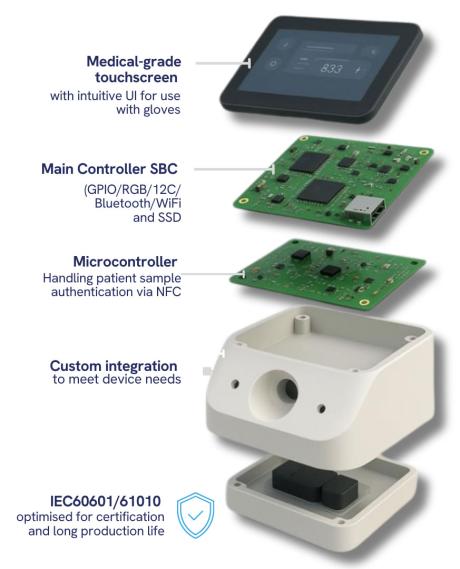Embedded Tech for Secure, Connected Medical Devices
Jul 29, 2025Explore how to build smarter medical devices with secure-by-design principles and resilient IoT connectivity. Learn…
Read moreThe medical industry is constantly seeking innovations that can transform patient care to significantly improve health outcomes. Anders collaborated with our customer to design and develop an advanced medical device to treat an immune and inflammatory disease via cell therapy.
This next-generation device, purpose-built to deliver proprietary therapeutic protocols, highlights how hardware and software innovation combined with thoughtful and capable engineering can assist with medical advancements.
Bringing a medical device to market involves navigating a web of stringent regulations. The device was a Class III device under US FDA’s medical device regulations and subject to Pre-Market Approval (PMA) 21 CFR Part 814 requiring clinical data in support of therapeutic claims. In addition, in Europe the device was subject to the requirements of the CE mark with specific IEC60601 / 61010 device and collateral EMC standards.
ISO13485 was a mandatory requirement for the organisation coupled with the relevant controls throughout its supply chain.
The device featured a robust fail-safe architecture combining advanced controllers, an advanced touch screen display system that could be used with medical gloves, intuitive user interaction controls and sophisticated power management systems to deliver the required therapeutic profiles. At its core was a single-board computer (SBC) acting as the main controller, equipped with GPIO, RGB, I2C, Bluetooth, Wi-Fi, and SSD capabilities.
Complementing the SBC was a secondary microcontroller managing patient sample authentication via NFC with ultra-low power sleep mode. In addition, this secondary controller performs the ongoing verification and monitoring of the critical parameters of the main system, is totally independent from the main control system. It has the ability to prevent the release of the treated cells if there is any deviation.

One of the defining features of this project was our flexibility in responding to the client’s evolving needs. While the original specification required QNX support, the client ultimately opted for broader motherboard compatibility by validating their software directly. Additionally, there was a shift in the control and monitoring of the cell processing systems which required changes in the sub-system architecture.
As a result of the close collaboration with our customer and our relationships with our manufacturing partners, all the changes were able to be accommodated within the project timelines.
In a multi-country clinical trial, over 200 devices were manufactured and deployed and achieved an uptime of 99.995% and zero device based adverse events reported over the four-year study period.

This project is a great example of our ability to partner with and deliver reliable, compliant technology solutions tailored to the unique demands of medical devices. By combining technical expertise with adaptive problem-solving, we ensured that the device met rigorous clinical technical and regulatory requirements. From accommodating changes in system requirements to delivering sub-systems optimised for the medical environment, we provided the support and innovation necessary to bring this ambitious project to fruition.